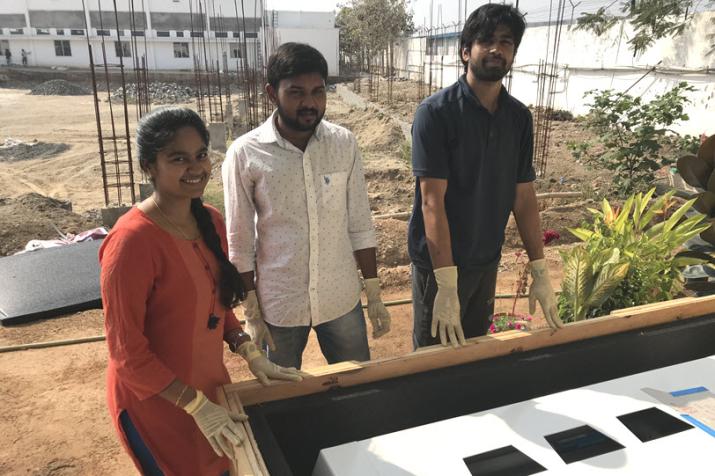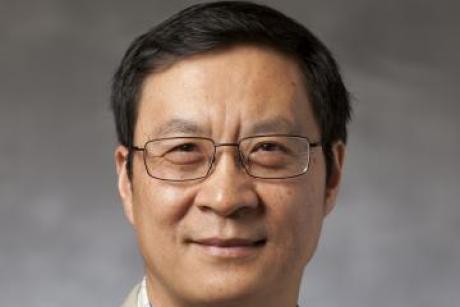
The Reclaimer field team in India
Published July 15, 2019, last updated on April 7, 2020 under Voices of DGHI
MSR Global Health and Duke University Center for Water, Sanitation, Hygiene and Infectious Disease (WaSH-AID) have partnered to create the Reclaimer, a prototype wastewater treatment system designed for the developing world. Essentially a closet-sized sanitation plant, the system is intended to help stop waterborne illness at the source, processing blackwater on-site in local communities. Learn about the team’s in-field testing from the project’s lead engineer.
Just before 8 a.m. on a Wednesday morning in late February, I stepped out of the airport in Coimbatore, Tamil Nadu, India. I had been travelling for 31 hours from Durham, NC, through Paris and Mumbai and finally to my destination. I was down a couple of tools thanks to airport security. I was very tired and in need of a shower.
And I had no intention of going to my hotel any time soon.
Meeting the field team
I recognized Sarani from the picture on her LinkedIn profile when she greeted me. We had been part of the same team for over a year, had exchanged countless emails, and been on many of the same conference calls, but this was the first time we’d met in person. She and her colleague Prateek are field-testing engineers working in Coimbatore through the Sanitation Technology Platform (STeP)—a collaboration of global experts and organizations accelerating innovations in sanitation—and I was here to help them install and commission the Reclaimer.
The Reclaimer is a prototype wastewater treatment system that our group at the Duke University Center for Water, Sanitation, Hygiene and Infectious Disease (WaSH-AID) has developed together with our partners at MSR Global Health. It represents a culmination of an intensive, two-year R&D effort that includes WaSH-AID and MSR in collaboration with Cranfield University and Triangle Environmental. It is designed to treat blackwater—wastewater from toilets—to stringent standards of biological safety and aesthetic acceptability, enabling water reuse on-site.
Engineers at MSR had built two units of the Reclaimer. One had been delivered to our labs in Durham, where I had spent the last several months overseeing extensive laboratory tests to confirm that it performed according to our design. The other had traveled from Seattle to Coimbatore (with a brief stop in Beijing for an exhibition) and was waiting for me in a crate at our field-testing site, a few kilometers away.

(But first, breakfast: masala dhosa and sambar. If you find yourself in southern India, do not miss out on this.)
From lab to real world testing
When engineers take a new technology from the controlled environment of the lab into the field, we learn whether what we have designed in theory can deliver in practice. In the case of sanitation systems, this is critical. Real-world patterns of use are difficult to replicate in the lab, and can be very unpredictable based on setting (public versus private), time of day, and even the seasons. The composition and quantity of waste streams vary greatly from person to person, day to day, and culture to culture.
Culturally specific bathroom practices can be especially challenging when we design these systems; for example, some cultures use toilet paper while others use water for cleaning. Whether a culture wipes or washes influences how much water and paper enters the system along with the waste. This in turn influences concentrations of the microbes, solids, organic material, and nutrients such as nitrogen and phosphorus that must be removed before water can safely be reused for flushing, washing, or irrigation. Moreover, understanding the preferences, habits, and needs of a community underpins the successful adoption of any new technology. After all, the best technology in the world is useless if no one wants to use it.
Visiting the test site
By the time the field team and I arrived at the cotton-spinning mill that serves as our test site, the sun was already rising high in the sky. Coimbatore is a mere 11 degrees above the equator—it is always hot there—and has been a center of cotton cultivation and processing for centuries. As we passed the bails of raw cotton stacked in the storage sheds, I thought about my grandfather, an agronomist who spent much of his career studying cotton in another very warm place (Georgia). He’d be amused to know that in a small way, the family had come full circle.

Prateek and Sarani recruited some of the workers in the mill to help us get the Reclaimer out of its crate. At 8 feet high, 3 feet wide, and 853 pounds, the unit is compact but not lightweight. With a lot of teamwork, we moved the unit into the testing area—an engineering space adjacent to the toilet block used by the women who live on site and work at the mill. From the users’ perspective, the toilets themselves do not look or function differently from any other. What happens after the flush is where the difference occurs.
Safe, effective sanitation in a box
Instead of waste draining to a sewer and traveling to a treatment plant, here it flows into the prototype technologies we want to test. The Reclaimer combines several treatment processes into a compact and fully automated system; in essence, it performs the work of a wastewater treatment plant, but in a much more compact footprint and without needing to move waste and water over long distances. Thus, the Reclaimer is designed to provide safe and effective sanitation to the billions of people who do not have it, and who live in places where building out the infrastructure necessary for municipal treatment is not feasible due to scarcity of land, water, and/or funding.

Once the machine was in position, things moved quickly. Within a few hours, I was able to email the following update to the team back home:
“Day one: out of the box, upright, plugged in, leak checked, PLCs updated, first run with tap water in progress. Couldn’t have asked for a smoother start!”
Shortly thereafter, I was asleep.

I spent the next few days working with Sarani and Prateek, running system checks and going over the procedures they would need to perform over the next six months to prepare the Reclaimer for the next phase of its development towards commercialization. We also got to know each other better, talking about our lives, our careers, and why we all choose to work in sanitation technologies instead of any number of other more “glamorous” fields. We have been in contact almost daily ever since, and I am both excited and privileged to be part of what we are going to achieve together.
Watch this video to learn more about the Reclaimer and hear directly from the team!
This post was originally published on the MSR blog, The Summit Register, and was republished with permission. Read Part 1 here.

